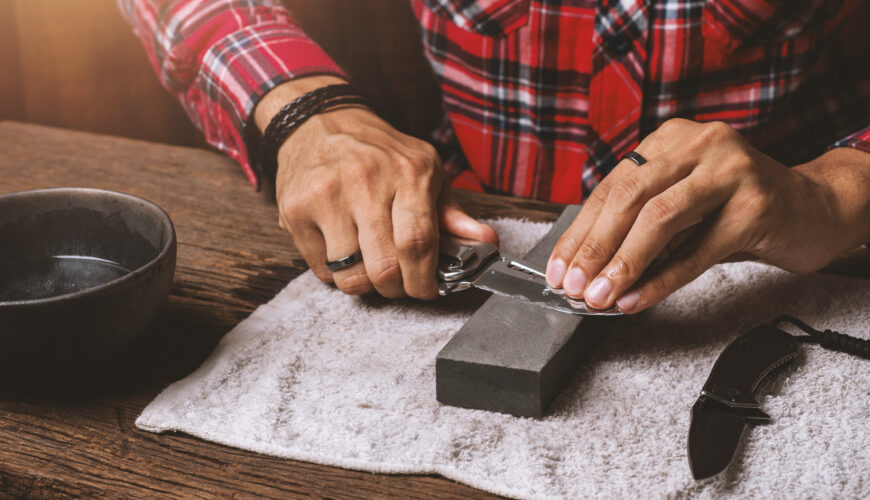Tactics
After The Shot: How to Blood Trail Your Deer
December 9, 2025 •Doug Howlett
August 16, 2023
Bailey Tillinghast is currently finishing his mechanical engineering degree, but like most students attending university, he’s had his fair share of day jobs. For eight years, he worked at a local Virginia butcher shop as a charcutier (a fancy French term for pork butcher, or someone who makes sausage), and during deer season had helped process the meat brought in by local hunters.
This experience, combined with a childhood in rural Pennsylvania where he spent most hunting seasons getting up before dawn with his uncle and stalking through the woods on his grandfather’s farm, has equipped Bailey with expert knowledge of long-term knife care — though he would humbly claim otherwise.
Whether it’s kitchen knives, hunting knives, or everyday carry knives (EDCs) many blade enthusiasts argue conflicting advice concerning long-term care for their blades. This is warranted in Bailey’s view, as a lot of knife care depends on personal preference and what you most often use your blade for.
This is probably the most frequently asked question: No one wants to find themselves field dressing only to learn that their blade has worn down after years of use. It is integral for hunters to learn how to hone and refine a blade.
“If you’re cutting meat, then you’ll most likely have to sharpen your knife more often,” Bailey said. “Meat has more resistance to your knife’s edge, so it’ll dull it out faster than say cutting softer materials like vegetables.”
However, the material you are quartering is not the only factor. Bailey said: “It also depends on the blade’s metal material. A softer metal will need sharpening more often than a harder metal.”
For those new to the world of aichmomania (or the obsession with knives), Bailey elaborated on how to tell the blade’s hardness, “Blades with a higher carbon content will have a harder metal, while knives with a lower carbon content will generally be softer.”
Knife enthusiasts may be determined to get the best product right out of the gate, but this isn’t such a simple task. Mostly because the “best” doesn’t exist.
“There is no ‘best’ knife sharpener, all knife sharpeners are different and it’s a matter of personal preference,” Bailey said. “Though, obviously, you get what you pay for.”
Bailey does recommend avoiding one type of knife sharpener: electric sharpeners.
Bailey said: “If you have a knife that you spent a lot of money on, electric sharpeners can take a lot of metal off and distort your blade.
“Electric sharpeners only have one type of grit. Typically, when you sharpen your knife, you’ll have two or three grits. You’d use your coarse grit whetstone first, then your higher grit whetstone to put a finer edge on it that will make it last longer.”
Bailey also advises to avoid any knife that claims to be self-sharpening. In his experience, they also don’t exist.
“It’s all marketing,” Bailey said. “There is no knife that sharpens itself.”
If you’ve followed Bailey’s advice thus far and find yourself with a decent knife sharpener that fits your needs (such as his personal favorite the Spyderco Tri-Angle Sharpmaker) you’re likely looking for tips on the finesse of blade honing.
Whetstones come in all shapes and sizes, and getting the hang of how to utilize them properly without damaging your blade can be a little tricky.
“When you’re using a traditional whetstone, you have to be mindful of your angle,” Bailey said. “The angle you want to sharpen your blade at will depend on its current conditions, but it’s typically around 20-30 degrees per side.”
Bailey shared a tip he learned to get this angle placement just right: take a folding matchbook and hold it against the blade edge while placing the blade on the stone. The angle that the blade sits with the matchbook beneath it will be about right.

For serrated blades, it’s not as complicated as you may think to refine their edges.
“You just need a whetstone that is made to fit into the grooves,” Bailey said. “Like a triangular whetstone.”
If you find that your sharpening process isn’t paying off, Bailey has a few trouble shooting tips as well.
“There are several different reasons why your knife may not be sharpening: you’re sharpening at the wrong grit, you’re not doing enough passes on the stones, you need to take more metal off…” Bailey said, “the material your knife is made from could be harder than normal — like stainless steel which takes a lot to sharpen.”
Bailey also suggests using a honing rod after every couple of uses to preemptively lessen the need for sharpening altogether.
Maybe you’re not a DIY type of person and you’d prefer to leave knife sharpening in the hands of professionals. While most butcher shops like the one Bailey worked at usually sharpen knives, he advises to proceed down this route with caution. Before you take your treasured blades to a butcher, you need to be able to trust that they’ll have someone knowledgeable doing the job.
Bailey prefers a first-party method that he described: “A lot of times, the company who made your knife will sharpen it for you. You just pay for shipping and send it to them for maintenance.”
Having a knife that will do the job time after time is a boon for both hunters and cuisine enthusiasts. So, whether you are an EDC-er or once-a-year field dresser, make sure you treat your knives well so they can be useful when it matters most.
